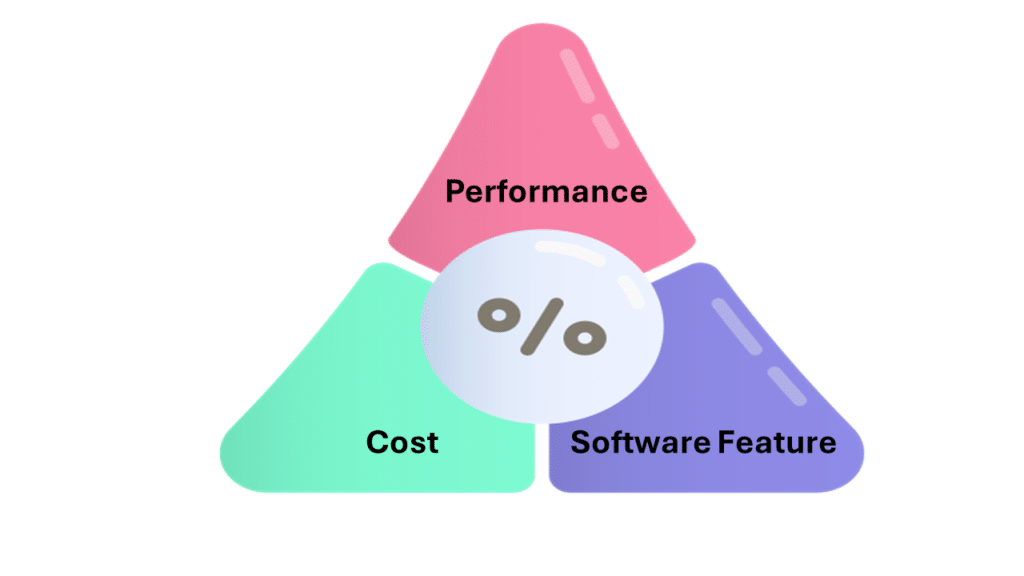
The world is increasingly connected to data, and the importance of storage efficiency cannot be ignored. From the exponential growth of data due to AI and IoT, understanding the knowledge of storage efficiency is necessary. In this article, we are working on introducing the essentials of storage efficiency.
The Factors Might Affect Your Choice
The storage efficiency might connect to different fields. For example, the IT infrastructure, the budget, and the actual requirement. When choosing a storage device, three key factors define its suitability: “Software Features”, “Performance”, and “Cost”. We’re going to introduce the three factors in the following paragraphs.
Software Features
To store data, the first thing is to check if the data can be preserved appropriately. Besides, the software features are as important as the function mentioned above. For example, storage management systems can surveillance devices’ status and manage the storage allocation.
- Storage Management
Storage Management plays a pivotal role in ensuring the seamless operation and organization of stored data. Efficient storage management involves tasks such as provisioning, monitoring, and optimizing storage resources. It allows businesses to allocate storage space appropriately, preventing underutilization or overallocation. Additionally, effective storage management contributes to improved performance by ensuring that data is stored in the most accessible and optimized manner. By implementing robust storage management features, organizations can streamline their data storage processes and enhance overall system efficiency.
- Data Protection
In the realm of storage efficiency, safeguarding data integrity is paramount. Data protection features are designed to reduce risks associated with data loss, corruption, or unauthorized access. This includes mechanisms such as encryption, access controls, and regular backups. Powerful data protection ensures the defensive ability of stored data against potential threats or unforeseen events. By incorporating advanced data protection features, businesses can keep the confidentiality, integrity, and availability of their critical data, thereby enhancing their storage infrastructure against potential vulnerabilities and ensuring compliance with data protection regulations.
Performance
Performance is a big topic of a storage device. It results in client and business efficiency. Therefore, finding a suitable storage device would be a critical part. Performance is more relevant to the hardware specifications like CPU, drive slot, and scalability port. So, the performance guide will be mentioned in the following paragraphs.
- Data Access Efficiency
Efficient data access is the backbone of every storage solution. Throughput and IOPS (Input / Output Per Second) are valid indicators to review storage solutions’ performance. Considering their significance in achieving optimal storage performance. By understanding the intricacies of access efficiency, businesses can choose the most suitable product according to their business workload.
- Data Store Efficiency
The ability to scale storage capacity is a key factor in adapting to data growth. Data stored in an organization will only grow as time goes by. Therefore, the available capacity becomes the most essential consideration. Not only the originally available capacity but also the flexible scalability can be beneficial to the upcoming data growth.
Cost
Cost is a pivotal factor in the selection of a storage solution, influencing the overall economic viability of the infrastructure. When evaluating costs, it’s essential to consider not just the upfront expenses but also the TCO (Total Cost of Ownership), encompassing maintenance, upgrades, and potential scalability costs. Additionally, businesses should assess the cost efficiency of the chosen solution about its performance and capacity. Striking the right balance between cost and functionality ensures that organizations invest wisely in a storage solution that aligns with their budget constraints while delivering the required performance and scalability. Careful consideration of cost factors enhances the overall value proposition and long-term sustainability of the chosen storage infrastructure.
Every penny counts in cost optimization, where data reduction emerges as the suitable solution, reshaping the landscape of TCO. Efficient data reduction techniques are valid for optimizing storage capacity and minimizing the physical space occupied by data. These techniques, including deduplication and compression, play a crucial role in reducing redundancy and squeezing out unnecessary data bloat. By implementing effective data reduction strategies, organizations can maximize their storage utilization, resulting in cost savings and improved performance. Data reduction not only benefits immediate storage needs but also facilitates efficient data transfer and replication, contributing to a more streamlined and responsive storage environment.
Conclusion
In practical terms, we can always find that only two factors can be taken into consideration when choosing storage devices. These factors, “Performance” and “Cost” are intricately linked to the overall success of the storage solution. Therefore, having a comprehensive understanding of the performance metrics, software features, and cost considerations is crucial for making informed decisions in aligning storage solutions with the specific needs and challenges of the organization.
Since data reduction can be a very complex issue, we’re going to introduce the data reduction features in the next article to help you understand how to decide whether you should adopt the data reduction policies.



